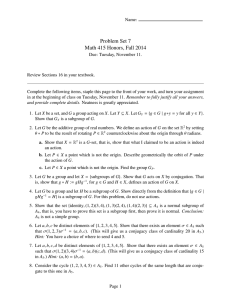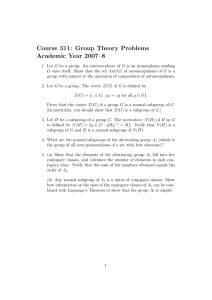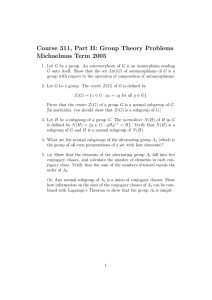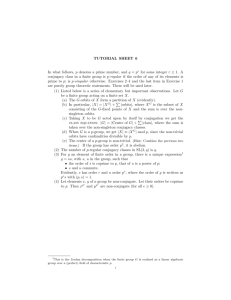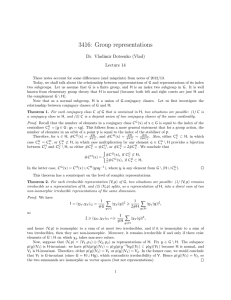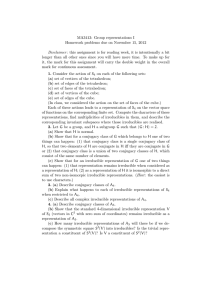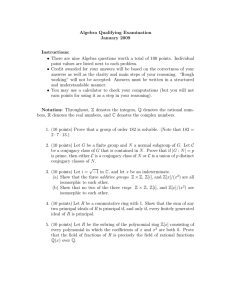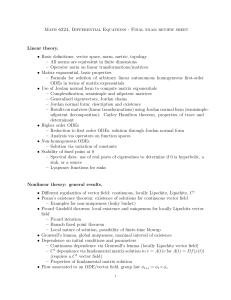Counting Conjugacy Classes of Elements of Finite Order in Lie Groups
advertisement
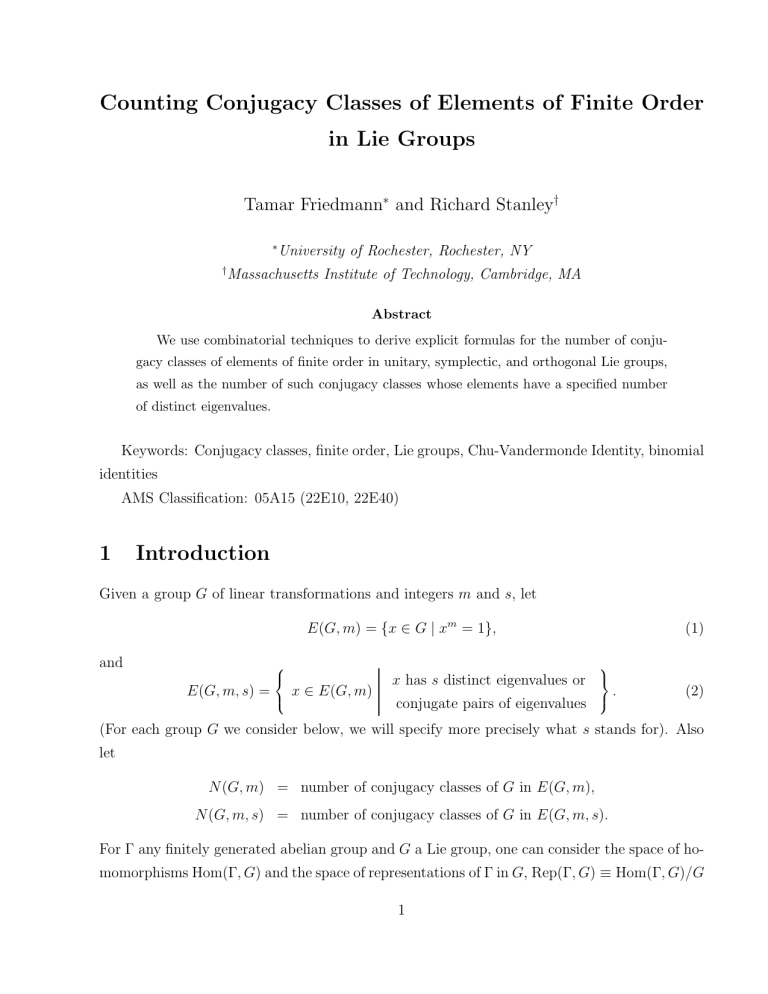
Counting Conjugacy Classes of Elements of Finite Order
in Lie Groups
Tamar Friedmann∗ and Richard Stanley†
∗
†
University of Rochester, Rochester, NY
Massachusetts Institute of Technology, Cambridge, MA
Abstract
We use combinatorial techniques to derive explicit formulas for the number of conjugacy classes of elements of finite order in unitary, symplectic, and orthogonal Lie groups,
as well as the number of such conjugacy classes whose elements have a specified number
of distinct eigenvalues.
Keywords: Conjugacy classes, finite order, Lie groups, Chu-Vandermonde Identity, binomial
identities
AMS Classification: 05A15 (22E10, 22E40)
1
Introduction
Given a group G of linear transformations and integers m and s, let
E(G, m) = {x ∈ G | xm = 1},
and
E(G, m, s) =
x ∈ E(G, m)
(1)
x has s distinct eigenvalues or
conjugate pairs of eigenvalues
.
(2)
(For each group G we consider below, we will specify more precisely what s stands for). Also
let
N(G, m) = number of conjugacy classes of G in E(G, m),
N(G, m, s) = number of conjugacy classes of G in E(G, m, s).
For Γ any finitely generated abelian group and G a Lie group, one can consider the space of homomorphisms Hom(Γ, G) and the space of representations of Γ in G, Rep(Γ, G) ≡ Hom(Γ, G)/G
1
(where G acts by conjugation); using this notation, E(G, m) = Hom(Z/mZ, G) and N(G, m) =
|Rep(Z/mZ, G)|. For the case Γ = Zn , the spaces Hom(Zn , G) and Rep(Zn , G) have been studied for various Lie groups G in [3, 1, 2, 4] (and references therein), where there has been interest
in their number of path-connected components and their cohomology groups.
It is the purpose of this paper to compute N(G, m) = |Rep(Z/mZ, G)| and N(G, m, s) for
G a unitary, orthogonal, or symplectic group. Unlike Rep(Γ, G) for Γ = Zn , the representation
space Rep(Z/mZ, G) is a finite set, so we can count its number of elements. The results are
summarized in Table 1.
The numbers N(G, m, s) have never been studied before in the mathematical literature.
What motivated their definition, as well as the definition of N(G, m), was the need to find
a formula for the number of certain vacua in the quantum moduli space of M-theory compactifications on manifolds of G2 holonomy. In that context, the numbers N(SU(p), q) and
N(SU(p), q, s), where q and p are relatively prime, were computed in [8]. These numbers are
related to symmetry breaking patterns in grand unified theories, with the number N(SU(p), q, s)
being particularly significant as s is related to the number of massless fields in the gauge theory
that remains after the symmetry breaking. The connections with symmetry breaking patterns arise from the fact that if M is a manifold and π1 (M) is its fundamental group, then
Rep(π1 (M), G) is the moduli space of isomorphism classes of flat connections on principal
G-bundles over M; in grand unified theories arising from string or M-theory, these flat connections (called Wilson lines) serve as a symmetry breaking mechanism. For more on the physical
applications and implications of these numbers, see [9].
As for N(G, m), certain cases have been studied previously in the mathematical literature,
using different techniques than ours. Two of the quantities we derive, Theorems 2.2 and 3.1,
were obtained in [5, 6] using the full machinery of Lie structure theory with a generating
function approach; in [16, 7], the case of certain prime power orders is computed; and in [11],
Theorem 2.6 is obtained. Our methods are different; they are purely combinatorial and direct,
and apply not only to simply connected or adjoint groups as in [5, 6], so we are able to derive
formulas for O(n), SO(n), and U(n) alongside those for SU(n) and Sp(n).
Other aspects of elements of finite order in Lie groups have been studied. See for example
[10, 13, 12, 14, 15].
In addition to the quantities N(G, m) and N(G, m, s), which count conjugacy classes of
elements of any order dividing m, we consider also conjugacy classes of elements of exact order
m in G: let
2
F (G, m) = {x ∈ G | xm = 1, xn 6= 1 for all n < m},
and
Also let
F (G, m, s) = x ∈ F (G, m)
x has s distinct eigenvalues or
.
conjugate pairs of eigenvalues
K(G, m) = number of conjugacy classes of G in F (G, m),
K(G, m, s) = number of conjugacy classes of G in F (G, m, s).
Since
X
N(G, m) =
K(G, d),
d|m
X
N(G, m, s) =
K(G, d, s),
d|m
we have, by the Mobius inversion formula,
m
),
d
d|m
X
m
K(G, m, s) =
µ(d)N(G, , s),
d
d|m
K(G, m) =
X
µ(d)N(G,
(3)
(4)
where µ(d) is the Mobius function.
The reader is invited to obtain K(G, m) and K(G, m, s) from Table 1 and equations (3)
and (4) above.
3
Table 1: Number of conjugacy classes of elements of finite order in Lie groups
G
m
U(n)
any
SU(n)
(n, m) = 1
any
N(G, m)
N(G, m, s)
n+m−1
m−1
s n
n s
1 n+m−1
m
n
1
m
P
φ(d)
d|(n,m)
s n
nm s
(n+m−d)/d
n/d
1
m
P
P
d|(n,m) j≥0
φ(d)
(n+m−jd−d)/d
(n−jd)/d
any
s n
n s
SO(2n + 1)
any
s n
n s
O(2n + 1)
2k + 1
s n
n s
O(2n)
2k + 1
s n
n s
SO(2n)
2k + 1
O(2n + 1)
2k
O(2n)
2k
SO(2n)
2k
n+[ m
]
2
n
n+[ m
]−1 n+m−1
2
n
n−1
n+ m
2
n
+
n+ m
−2
2
n
s
s
s
m+1−s
[ m2 ]+1−s
2
4
h m
s n
n s
2
2
s
+1
s
m
2n−s−1 n−2
n−s
s−1
[ m2 ]+1
2s n
n s
[ m2 ]+1
m
−1 4n+m
n+ m
2
n−1
2n
n+ m
2
n
s
[ m2 ]
s n
n s
[ m2 ]+1
n+[ m
]
2
n
m/d
j
]
n+[ m
2
n
[m
]+1
2
s
]
n+[ m
2
n
2
m
s
Sp(n)
m
s
+
2
+1
s
m
i
−1
s−2
2
jd
s
(−1)j+s
2
Counting conjugacy classes in unitary groups
We begin with N(U(n), m), with no conditions on the integers m and n. Since every element
of U(n) is diagonalizable, every conjugacy class has diagonal elements. The diagonal entries
are mth roots of unity, e2πikj /m , kj = 0, . . ., and m − 1, j = 1, . . . , n. In each conjugacy class
there is a unique diagonal element for which the diagonal entries are ordered so that the kj
are nondecreasing with j. Therefore, N(U(n), m) is the number of such diagonal matrices with
nondecreasing kj .
Let {nk } = (n0 , . . . , nm−1 ),
Pm−1
k=0
nk = n with nk ≥ 0. Such a sequence is a weak m-
composition of n, and it is well-known that there are
n+m−1
m−1
such sequences [17]. There is
a bijective map between such sequences and diagonal matrices in U(n) with ordered entries:
{nk } corresponds to the diagonal U(n) matrix with nk repetitions of the eigenvalue e2πik/m :
diag(1, 1, · · · , 1, e2πi/m , · · · , e2πi/m , · · · , e2(m−1)πi/m , · · · , e2(m−1)πi/m ) .
|
} |
{z
n0
{z
n1
|
}
{z
(5)
}
nm−1
Thus N(U(n), m) is the number of weak m-compositions of n, so we obtain the following
formula.
Theorem 2.1 For any positive integers n and m,
n+m−1
N(U(n), m) =
m−1
!
(6)
Note that N(U(n), m) is also the number of inequivalent unitary representations of Z/mZ of
dimension n.
Now we turn to the special unitary group SU(p), and calculate N(SU(p), q) where (p, q) = 1.
Given a sequence {nk }, k = 0, . . . q − 1 with
Pq−1
k=0 nk
= p, nk ≥ 0 (i.e., a weak q-composition
of p), the determinant of the corresponding matrix x is exp 2πi
q
det x = 1 requires
P
k
P
q−1
k=0
knk , so the condition
knk ≡ 0 mod q. Thus for a weak q-composition of p to determine a
matrix in SU(p), we need
P
k
knk ≡ 0 mod q.
We now show the family of weak q-compositions of p are partitioned into sets of size q where
in each such set there is exactly one such composition with
sequences
(j)
{nk } = {nk+j }
P
knk ≡ 0. Consider the q distinct
j = 0, 1, . . . , q − 1 , indices are understood mod q.
(7)
(The only way for the sequences not to be distinct is if all nk were equal, which would imply
qnk = p, impossible when (p, q) = 1). The determinant of the matrix xj corresponding to the
5
P
q−1
j th sequence is exp 2πi
q
k=0 knk+j
q−1
X
k=0
. Since (p, q) = 1 and
knk+j −
q−1
X
knk+j+1 ≡ p mod q ,
(8)
k=0
P
exactly one of the q values of j gives the sum
k
value of j. We conclude:
knk+j ≡ 0 mod q, so det(xj ) = 1 for that
Theorem 2.2 For (p, q) = 1,
!
(p + q − 1)!
1 p+q−1
=
.
N(SU(p), q) =
q−1
q
p! q!
(9)
Now we turn to counting conjugacy classes whose elements have a given number s of distinct
eigenvalues. We begin with N(U(n), m, s). A U(n) matrix with s distinct eigenvalues (which
has centralizer of the form Πsi=1 U(ni )) corresponds to a sequence {na } = (n1 , . . . ns ),
n, na ≥ 1. Such a sequence is an s-composition of n and there are
[17]). There are also
following formula.
m
s
n−1
s−1
Ps
a=1
na =
such sequences
ways to choose the s eigenvalues themselves. We therefore obtain the
Theorem 2.3 For any positive integers n and m,
!
n−1
N(U(n), m, s) =
s−1
!
!
s n
m
=
n s
s
!
m
s
.
(10)
For the special unitary group, again we impose (p, q) = 1. Given an s-composition of p,
{na } = (n1 , . . . ns ),
Ps
a=1
na = p, na > 0, consider {λa } = (λ1 , . . . , λs ) where λa ∈ {0, . . . , q − 1}
determine the eigenvalues e
q
s
2πiλa
q
with multiplicity na of the corresponding matrix. Arrange the
s! possibilities for {λa } in sets of size q given by
{λ(j)
a } = (λ1 + j, . . . , λs + j), j = 0, . . . , q − 1
(all numbers are understood mod q).
(11)
The determinant of the matrix xj corresponding to the j th choice is
!
s
2πi X
na (λa + j) .
exp
q a=1
Since (p, q) = 1 and
X
na (λa + j) −
a
X
na (λ + j + 1) = p,
a
exactly one of the q matrices has determinant 1. Since so far neither the λa ’s nor the na ’s
have been ordered, once we arrange the eigenvalues to have increasing λa ’s, each matrix would
appear s! times. Dividing by s!q, we obtain
6
Theorem 2.4 For (p, q) = 1,
1 p−1
N(SU(p), q, s) =
q s−1
!
!
s p
q
=
s
pq s
!
q
s
!
.
(12)
From Theorems 2.2 and 2.4, we deduce an intriguing symmetry between p and q:
Corollary 2.1 For (p, q) = 1,
N(SU(p), q) = N(SU(q), p);
N(SU(p), q, s) = N(SU(q), p, s).
This symmetry has implications involving dualities of gauge theories; see [9].
It is clear that for any G and m, we must have
X
N(G, m, s) = N(G, m).
(13)
s
Since N(G, m, s) = 0 when s > m, the sum is finite. Applying equation (13) to G = U(n) gives
X
s
n−1
s−1
!
!
!
n+m−1
m
,
=
m−1
s
(14)
which is a special case of the Chu-Vandermonde identity [17].
We may also obtain both N(SU(n), m) and N(SU(n), m, s) without requiring (n, m) = 1
via a generating function approach. Let
F (x, t, u) =
m−1
Y
1+u
∞
X
k
(t x)
a=1
k=0
a
!
.
A typical term in F (x, t, u) is
P
x
nk
P
t
knk
us ,
where nk , k = 0, . . . , m−1 are nonnegative integers and s is the number of k’s for which nk 6= 0.
If
P
nk = n and
P
knk ≡ 0 mod m then the sequence {nk } corresponds to a diagonal SU(n)
matrix of order m with s distinct eigenvalues. To pick out the terms in F (x, t, u) for which
P
knk ≡ 0 mod m, let ζ = exp 2πi/m and recall
1, if m|b
X jb
1 m−1
ζ =
,
m j=0
0, else
so
G(x, u) =
X
X
1 m−1
F (x, ζ j , u) =
N(SU(n), m, s)xn us .
m j=0
n,s
7
(15)
Rewriting
1+u
∞
X
!
(tk x)a = (1 − u) +
a=1
we have
G(x, u) =
u
1 − tk (1 − u)x
=
,
1 − tk x
1 − tk x
X m−1
Y 1 − ζ kj (1 − u)x
1 m−1
.
m j=0 k=0
1 − ζ kj x
(16)
For ζ j a primitive dth root of unity, we have the factorization (1 − xd ) =
Qd−1
l=0 (1
− ζ jl x). Since
ζ j , j = 0, . . . , m − 1 is a primitive dth root of unity φ(d) times, where φ(d) is Euler’s function,
we have
G(x, u) =
1
φ(d)
m d|m
X
h
1 − (1 − u)dxd
im/d
(1 − xd )m/d
.
(17)
Expanding in binomial series gives
!
X
1 X
k + m/d − 1
φ(d)
G(x, u) =
m d|m
k
k,j,l≥0
m/d
j
!
!
jd
(−1)j+l xd(k+j) ul .
l
Setting d(k + j) = n and l = s, we have
Theorem 2.5 For any positive integers n, m, and s,
1 X X
n/d + m/d − j − 1
N(SU(n), m, s) =
φ(d)
m d|(n,m) j≥0
n/d − j
!
m/d
j
!
!
!
!
jd
(−1)j+s .
s
(18)
We may deduce from Theorems 2.5 and 2.4 that for (p, q) = 1,
1 X p+q−j −1
q j≥0
p−j
!
q
j
!
!
s p
j
(−1)j+s =
pq s
s
q
.
s
(19)
For N(SU(n), m) we apply equation (13), or equivalently set u = 1 in G(x, u), and obtain (see
also [11]) the next result.
Theorem 2.6 For any positive integers n and m,
!
n/d + m/d − 1
1 X
.
φ(d)
N(SU(n), m) =
m d|(n,m)
n/d
8
(20)
3
Counting conjugacy classes in symplectic groups
The diagonal elements of U(n) and SU(p) that we counted in the previous section belonged to
the maximal tori of those groups. For Sp(n) ≡ Sp(n, C) ∩ U(2n), the maximal torus is
n
o
TSp(n) = (e2πiθ1 , . . . , e2πiθn , e−2πiθ1 , . . . , e−2πiθn ) .
Since Sp(n) is compact and connected, we have Sp(n) =
S
x∈G
(21)
xTSp(n) x−1 . Hence, every element
x ∈ G can be conjugated into the torus, so every conjugacy class has elements in TSp(n) . Any
two elements x and x′ of TSp(n) that differ only by θl′ = −θl for some l’s are in the same
conjugacy class; the symplectic matrix El,n+l − En+l,l , where (Eab )cd = δac δbd , conjugates them.
So a conjugacy class is fully determined by n values of θl restricted to [0, 1/2].
Conjugacy classes of elements of order m have a unique element in TSp(n) such that θl ∈
1
(0, 1, . . . , [ m2 ])
m
and the θl are nondecreasing as i runs from 1 to n. Following the arguments
leading to Theorem 2.1, and noting that here we have weak ([ m2 ] + 1)-compositions of n, rather
than weak m-compositions of n, we obtain our next theorem.
Theorem 3.1 For any positive integers n and m,
!
n + [ m2 ]
.
N(Sp(n), m) =
[ m2 ]
(22)
We now consider N(Sp(n), m, s) where s denotes the number of complex conjugate pairs of
eigenvalues. Following the arguments leading to Theorem 2.3, but replacing m by ([ m2 ] + 1),
we have
Theorem 3.2 For any positive integers n, m, and s,
n−1
N(Sp(n), m, s) =
s−1
9
!
!
[ m2 ] + 1
.
s
(23)
4
Counting conjugacy classes in orthogonal groups
The maximal tori of the different orthogonal groups depend on the parity of l in SO(l) or O(l)
and also on whether the orthogonal group is special or not:
TSO(2n) = {diag(A(θ1 ), A(θ2 ), . . . , A(θn ))} ,
(24)
TSO(2n+1) = {diag(A(θ1 ), A(θ2 ), . . . , A(θn ), 1)} ,
TO(2n) =
TO(2n+1) =
where
T1,even = diag(A(θ1 ), A(θ2 ), . . . , A(θn ))
T2,even = diag(A(θ1 ), A(θ2 ), . . . , A(θn−1 ), B)
T1,odd = diag(A(θ1 ), A(θ2 ), . . . , A(θn ), 1)
T2,odd = diag(A(θ1 ), A(θ2 ), . . . , A(θn ), −1)
cos 2πθ
A(θ) =
The identity
(25)
sin 2πθ
− sin 2πθ cos 2πθ
; B=
BA(θ)B −1 = A(−θ)
1
−1
.
,
,
(26)
(27)
(28)
(29)
will become useful below.
With the maximal tori defined as above, every element of the orthogonal group can be
conjugated to the torus, so each conjugacy class has a nonempty intersection with the group’s
maximal torus.
The counting of conjugacy classes depends on the parity of the order m of the elements, so
we treat the odd and even cases separately.
4.1
Odd m
We begin with N(SO(2n+1), m). The block-diagonal matrix diag(B, I2n−2 , −1) is an element of
SO(2n+1) and equation (29) shows that conjugation by it takes x ∈ TSO(2n+1) to x′ ∈ TSO(2n+1)
where θ1′ = −θ1 and the other θi remain the same. Similarly, two elements x and x′ of TSO(2n+1)
that differ by θl′ = −θl for any l = 1, . . . , n belong to the same conjugacy class. We therefore
consider only elements of TSO(2n+1) with θl ∈ [0, 1/2] as we did for the symplectic case. As
before, we order the θl to be nondecreasing with l.
For elements of order m, we have θl ∈
of weak
([ m2 ]
1
(0, 1, . . . , [ m2 ]).
m
+ 1)-compositions of n:
10
So N(SO(2n + 1), m) is the number
Theorem 4.1 For any positive integer n and any odd integer m = 2k + 1,
N(SO(2n + 1), m) =
n+
h i!
m
2
.
h i
m
2
(30)
For O(2n + 1), there are two conjugacy classes of maximal tori, i.e., TSO(2n+1) , and T2,odd in
equation (27). However, all elements of T2,odd have even order, so none has order m = 2k + 1.
Therefore, the number of conjugacy classes of elements of odd order in O(2n + 1) is the same
as that for SO(2n + 1), so we get the following result.
Theorem 4.2 For any positive integer n and any odd integer m = 2k + 1,
N(O(2n + 1), m) =
n+
h i
m
h i2
.
m
2
(31)
For O(2n), again T2,even ∈ TO(2n) does not play a role when m is odd. Also, the block diagonal
matrix diag(B, I2n−2 ) is an element of O(2n), so the results for O(2n + 1) and O(2n) are the
same.
Theorem 4.3 For any positive integer n and any odd integer m = 2k + 1,
N(O(2n), m) =
n+
h i
m
h i2
m
2
.
(32)
Things become more subtle for SO(2n): diag(B, I2n−2 ) has determinant −1 so it is not an
element of SO(2n). Therefore, it is no longer the case that if x, x′ ∈ TSO(2n) differ only by
θi′ = −θi for some i’s then x and x′ are necessarily in the same conjugacy class. However, the
block diagonal matrix diag(B, B, I2n−4 ) is in SO(2n), so if θl′ = −θl for an even number of l’s,
so x and x′ are in the same conjugacy class.
There are two cases to consider: θ1′ = θ1 = 0 and θl 6= 0 for all l. In the first case,
A(θ1 ) = A(θ1′ ) = I2 , and if θl′ = −θl for any additional l ≥ 2 (not necessarily an even number of
times), then x and x′ are in the same conjugacy class. The number of conjugacy classes that are
represented by elements of TSO(2n) with θ1 = 0 is the number of weak
h i
m
2
+ 1 -compositions
of n − 1. In the second case θl 6= 0 for all l, the number of classes is the number of weak
h i
m
2
-compositions of n; since here, flipping the sign of one θl , say θ1′ = −θ1 and leaving the
others fixed lands in a different conjugacy class, we multiply the number by two to include all
the classes. This leads to the following theorem.
11
Theorem 4.4 For any positive integer n and any odd integer m = 2k + 1,
N(SO(2n), m) =
n+
h i
m
2
h i
m
2
−1
!
+2
n+
h i
m
2
h i
m
2
−1
−1
!
=
n+
h i
m
2
h i
m
2
!
−1 n+m−1
.
n
(33)
We now turn to N(SO(2n + 1), m, s), where as for the symplectic groups, s denotes the
number of distinct conjugate pairs of eigenvalues of the elements. For all the orthogonal groups,
there are n θl ’s and
n−1
s−1
=
s n
n s
ways to partition them into s nonzero parts. There are
h i
m
2
+1
possible values for the θi . The same is true for O(2n + 1), and O(2n), yielding the next result.
Theorem 4.5 For any positive integers n and s, and any odd integer m = 2k + 1,
s n
N(SO(2n + 1), m, s) = N(O(2n + 1), m, s) = N(O(2n), m, s) =
n s
! hmi
2
!
+1
.
s
(34)
The above derivation does not apply to SO(2n) because as before, some classes need to be
counted twice due to the absence of (B, I2n−2 ) in SO(2n). First, we divide the n eigenvalue
pairs into s nonzero parts (s-compositions of n). In choosing the s eigenvalues out of the
h i
m
2
+1
possibilities, we differentiate the cases where θ1 = 0, which we count once, from the cases where
θ1 6= 0, which we need to count twice to account for θ1′ = −θ1 , θl′ = θl , l > 1 which is in a
distinct conjugacy class. We get the following formula.
Theorem 4.6 For any positive integers n and s and any odd integer m = 2k + 1,
N(SO(2n), m, s) =
=
4.2
n−1
s−1
h i
m
2
s−1
h i
h i
+2
m
2
s
s n m2 m + 1 − s
h i
.
m
n s
+
1
−
s
s
2
Even m
Unlike the case for odd m, here we will have to consider T2 in both O(2n) and O(2n + 1).
There will also be changes from the odd m case due to the fact that θl = 1/2, corresponding
to A(θl ) = −I2 , can appear.
For SO(2n + 1), we have essentially the same as we did for odd m, i.e., weak
compositions of n.
12
m
2
+1 -
Theorem 4.7 For any positive integer n and any even integer m = 2k,
N(SO(2n + 1), m) =
n+
m
2
m
2
.
(35)
For O(2n + 1), we have to consider conjugacy classes with elements in T2,odd of TO(2n+1) . But
the counting is exactly the same as in T1,odd , so the next theorem follows.
Theorem 4.8 For any positive integer n and any even integer m = 2k,
N(O(2n + 1), m) = 2
n+
m
2
m
2
.
(36)
Turning to O(2n), we note that elements in T2,even have only n − 1 θl ’s. Other than that, the
counting is the same as before, and we have
Theorem 4.9 For any positive integers n and any even integer m = 2k,
n+
n+
N(O(2n), m) =
=
m
2
m
2
m
2
m
2
−1
+
n+
m
2
m
2
−1
4n + m
.
2n
For SO(2n), again we need to be careful since θl′ = ±θl does not always mean x and x′ are in
the same conjugacy class. Only when at least one of the θi is 0 or 1/2, so that A(θl ) = ±I2
for that l, which commutes with B, does θl′ = ±θl mean x and x′ are in the same conjugacy
class. If no θl is 0 or 1/2 then if say θ1′ = −θ1 and θl′ = θl , l > 1, we have a different conjugacy
class for x and x′ . The number of conjugacy classes such that at least one θl is 0 or 1/2 is the
number of weak
of weak
m
2
m
2
+ 1 -compositions of n − 1 (where we have fixed θ1 = 0) plus the number
-compositions of n − 1 (where we do not allow θl = 0 and we require θl = 1/2 for
some l). The number of conjugacy classes where no θl is 0 or 1/2 is twice the number of weak
m
2
− 1 -compositions of n. After some algebra we obtain the next result.
Theorem 4.10 For any positive integer n and any even integer m = 2k,
N(SO(2n), m) =
n+
m
2
m
2
+
n+
m
2
m
2
−2
−2
.
(37)
For N(SO(2n+1), m, s), we have the same calculation as for odd m, and for N(O(2n+1), m, s),
we simply double the result to account for the elements in T2,odd , giving
13
Theorem 4.11 For any positive integers n and s and any even integer m = 2k,
m
2
m
2
s n
N(SO(2n + 1), m, s) =
n s
2s n
N(O(2n + 1), m, s) =
n
s
+1
s
+1
s
;
.
Next is O(2n), where T2,even has only n − 1 θl ’s, so the contribution from T2,even differs from
that from T1,even by replacing n with n − 1. After some algebra we get the following theorem.
Theorem 4.12 For any positive integers n and s and any even integer m = 2k,
2n − s − 1 n − 2
N(O(2n), m, s) =
s−1
n−s
!
m
2
!
+1
.
s
(38)
For SO(2n), for each s-composition of n, the number of conjugacy classes of TSO(2n) with
θl 6= 0, 1/2 for all l is
θl = 0, 1/2 is the sum of
and
m
2
−1
m
2
−1
s
m
2
s−1
,
and the number of conjugacy classes with at least one
,
which gives the number of conjugacy classes with θ1 = 0,
which gives the number of conjugacy classes with θl 6= 0 ∀l and θl = 1/2 for
s−1
some l. As before, we multiply the number for θl 6= 0, 1/2 by 2, and add the rest. After some
algebra, we have our final result.
Theorem 4.13 For any positive integers n and s and any even integer m = 2k,
N(SO(2n), m, s) =
n−1
s−1
m
2
+1
s
+
m
2
−1
s
.
(39)
Acknowledgments
It is a pleasure to thank Jonathan Pakianathan, Steve Gonek, Ben Green, and Dragomir
Djokovic for discussions. It is also a pleasure to thank Jonathan Pakianathan for comments on
an earlier draft. The work of the first author was supported in part by US DOE Grant number
DE-FG02-91ER40685, and of the second author in part by NSF Grant number DMS-1068625.
14
References
[1] A. Adem, F. R. Cohen, “Commuting elements and spaces of homomorphisms,” Math.
Ann. 338 (2007), no. 3, 587-626; Erratum.
[2] A. Adem, F. R. Cohen, and J. M. Gomez, “Commuting elements in central products of
special unitary groups,” arXiv:0905.2895.
[3] A. Borel, R. Friedman, and J. W. Morgan, “Almost commuting elements in compact Lie
groups,” Mem. Amer. Math. Soc. 157 (2002) no. 747.
[4] T. Baird, L. C. Jeffrey, and P. Selick, “The space of commuting n-tuples in SU(2),” Illinois
J. Math, to appear, arXiv:0911.4953.
[5] D. Z. Djokovic, “On conjugacy classes of elements of finite order in compact or complex
semisimple Lie groups,” Proc. Amer. Math. Soc. 80 (1980), no. 1, 181–184.
[6] D. Z. Djokovic, “On conjugacy classes of elements of finite order in complex semisimple
Lie groups,” J. Pure Appl. Algebra 35 (1985), no. 1, 1–13.
[7] F. Destrempes and A. Pianzola, “Elements of compact connected simple Lie groups with
prime power order and given field of characters,” Geometriae Dedicata 45, 225 (1993).
[8] T. Friedmann, “On the Quantum Moduli Space of M–Theory Compactifications,” Nucl.
Phys. B 635: 384-394, 2002.
[9] T. Friedmann, “The string landscape: on formulas for counting vacua,” preprint.
[10] V. Kac, “Automorphisms of finite order of semisimple Lie algebras,” Func. Anal. Appl. 3
(1969) 252.
[11] O. P. Lossers, Solution to problem 288, Canad. Math. Bull. 26 503 (1983).
[12] M. de Montigny, “Elements of finite order in Lie groups and discrete gauge symmetries,”
Nucl. Phys. B 439, 665 (1995) [hep-th/9406064].
[13] R. V. Moody and J. Patera, “Characters of elements of finite order in Lie groups,” SIAM
J. Alg. Disc. Meth. 5 (1984) no. 3, 359.
[14] A. Pianzola, “On the arithmetic of the representation ring and elements of finite order in
Lie groups,” J. Algebra 108 (1987), 1.
[15] A. Pianzola, “On the rationality and regularity of certain elements of finite order in Lie
groups,” J. reine Angew. Math. 377 (1987), 40.
15
[16] A. Pianzola and A. Weiss, “The rationality of elements of prime order in compact connected
simple Lie groups,” J. Alg. 144, 510 (1991).
[17] R. Stanley, Enumerative Combinatorics, Vol. 1, Cambridge University Press, Cambridge,
2012.
16
